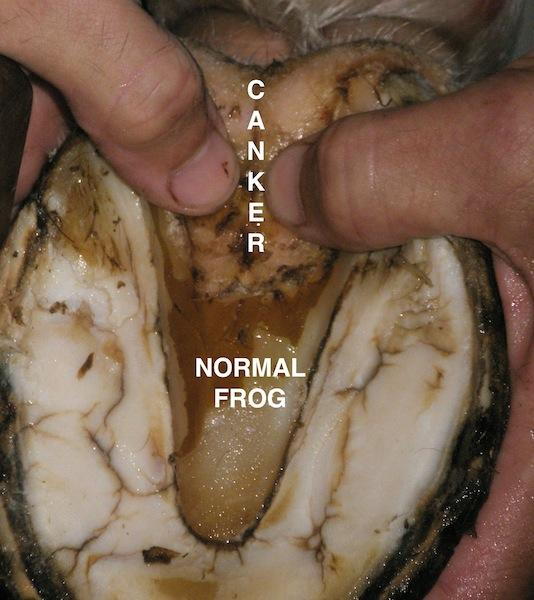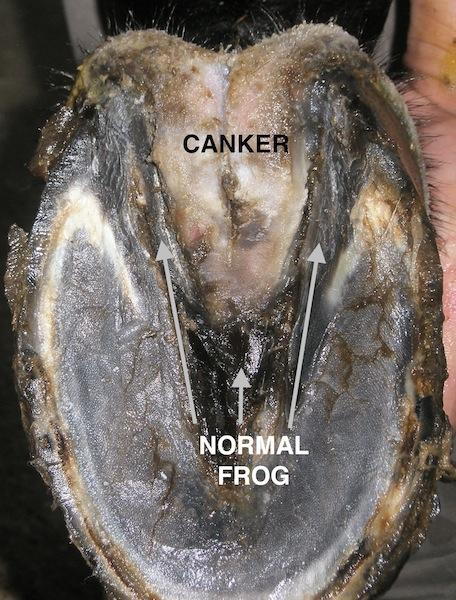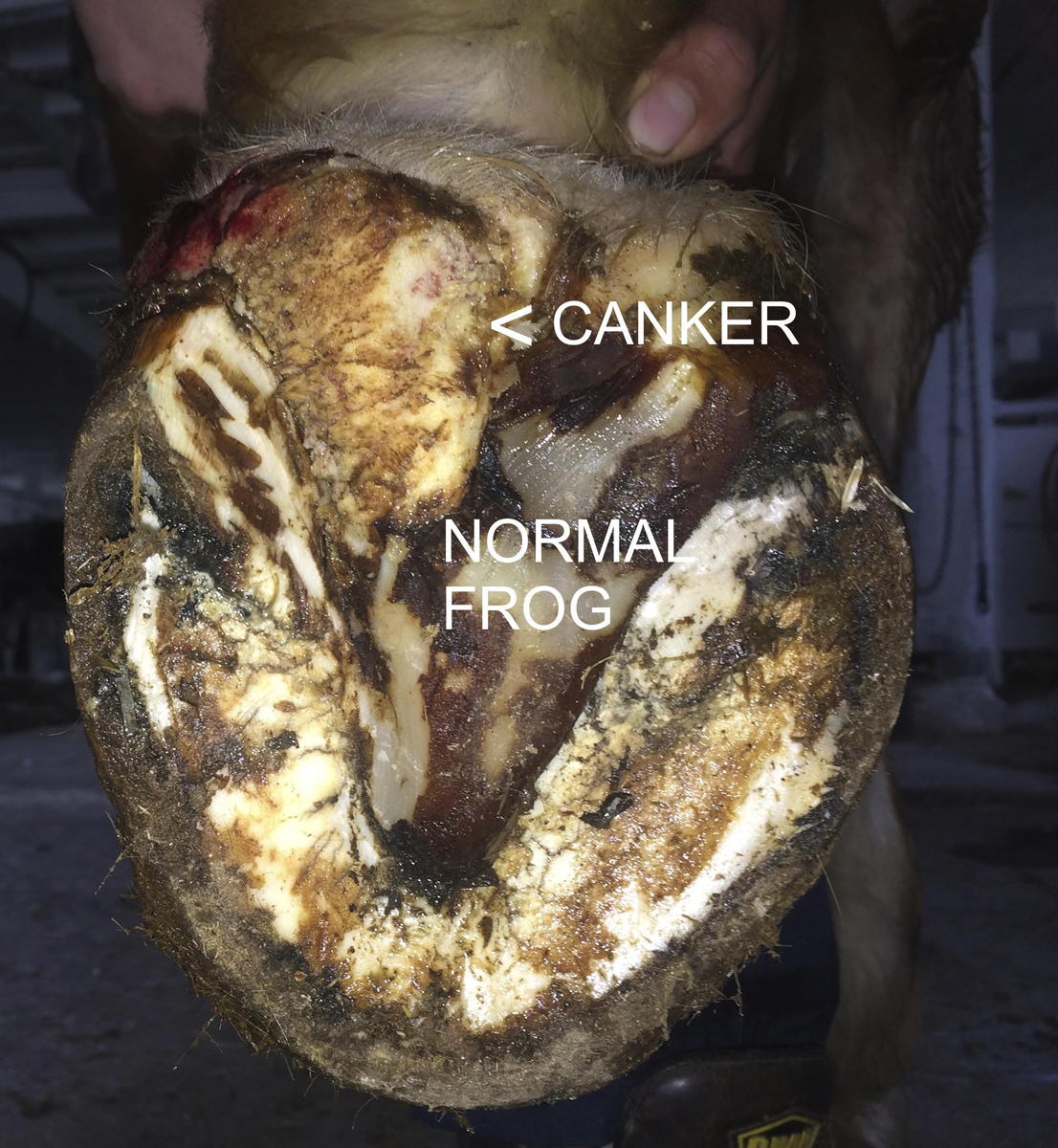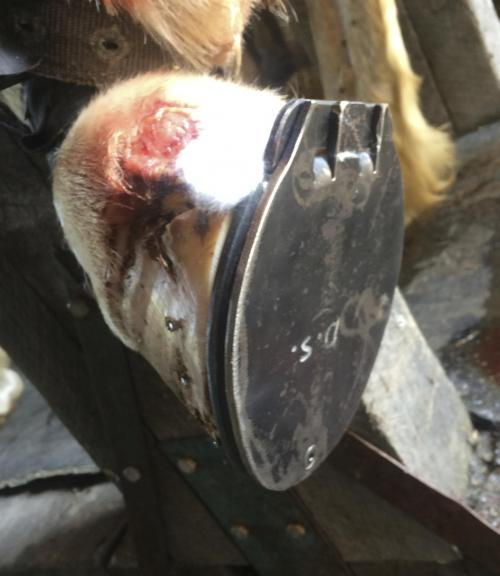CANKER
- posted: Jul. 31, 2014

CANKER (adapted from the spring 2011 OPHA newsletter) by Ken Keckler DVM
There are two "infections" commonly associated with a horse's frog. The most common is thrush, previously discussed here. Canker is much less common, and much more challenging to treat. It's interesting that both of these are also names for human mouth abnormalities: thrush is a yeast infection most often seen in babies' mouths, and canker sores are oral ulcers associated with consuming acidic citrus products.
Canker may look somewhat like thrush in its' early stages, but can start anywhere on the frog. While it was originally thought to be a problem only in draft horses, it can be seen in any breed. It can be found in any (or every) foot. The specific cause has not been determined, although some have speculated that a bacterium is responsible. It does not correlate with a wet environment, and is not contagious. It may start out as an off white to grayish area that becomes obviously different from the rest of the frog. If left unchecked, canker will continue to proliferate (grow), sometimes getting a cauliflower like appearance. It can grow out into the sole and even push its way through the hoof wall, destroying the normal architecture. Deformed/damaged hoof will not provide normal support, and will lead to discomfort. Lameness can result, as the abnormal tissue can be sensitive, and it will bleed very easily if aggravated. An odor may or may not be present. Diagnosis may be aided by a biopsy, but most often canker can be identified by its typical appearance.

When asking veterinarians and farriers about treatment, you will find dozens of answers, with none being 100% successful. Dr. Stephen O'Grady from Northern Virginia Equine is looked upon as the "expert" on canker, as he has an approach that tends to work. Therapy in the early stages has a higher chance of cure, as large, proliferative masses are difficult to control, and damage to sole and hoof wall can cause structural imbalance in the foot, causing further problems.

To treat, the foot is properly trimmed, nerve blocked (numbed), and a tourniquet applied. (This procedure will bleed profusely, making it impossible to see the structures without controlling blood flow.) The canker and surrounding frog is surgically removed (using a hoof knife at first, and a scalpel blade as you progress) until you come to healthy, normal looking tissue. I must admit, in the feet I have treated, this demarcation is not as obvious as I would like. Canker in the central sulcus that extends deeply up into the heel bulbs can be challenging to get to, and much of the support provided by the frog may be removed during the surgery. This horse will be on long-term stall rest while he recuperates.

When all the canker has been removed, cryotherapy is applied to the remaining tissue. (Freezing, using liquid Nitrogen or inverted cans of "Dust Off"). Hopefully, this freeze will kill any remaining canker cells. A topical solution is employed daily for an extended time period. I have used a combination of DMSO, metronidazole, and Oxytetracycline. (This combination smells nasty, thereby making it more effective!) Dr. O'Grady uses a benzoyl peroxide/metronidazole mixture.
Sometimes hospital plates are used to protect the feet, but, depending on the case, leather or plastic boots can be effective. The frog will grow back slowly, beginning to "cornify" (become more recognizable as horny frog) in about a month. There is always the chance that it could reoccur and need further attention. Be ready to invest some time, effort and money if you are going to treat canker.

An example of a hospital plate
Last fall I was presented with a horse that had canker in all four feet, which was sensitive enough to make him lame. We treated the front feet as described above, and two weeks later, treated the hind feet. We lost the fall show season, as expected. Watching the frogs grow back, we monitored areas of suspicious tissue, aware that we may need to re-treat. Over the course of 7-8 weeks, normal frog appeared, sensitivity went back to normal, and we put him back into work. Recently he has competed successfully in the local hunter rings and seems to be fully recovered. Early recognition and treatment is very important.
Remember that your horse needs a dry stall to stand in, and exercise to promote healthy feet. Clean his feet everyday and watch for discoloration of the frog and sole, and for the black, foul smelling debris of thrush. Any strange appearance to your horse's feet should be evaluated by your farrier, and possibly your veterinarian.
Location
Find us on the map
16295 Claridon Troy Road
Burton, OH 44021, US
Office Hours
24 Hour Emergency Care - 365 Days a Year
8:00 am - 4:30 pm
8:00 am - 4:30 pm
8:00 am - 4:30 pm
8:00 am - 4:30 pm
8:00 am - 4:30 pm
Emergencies Only
Emergencies Only

